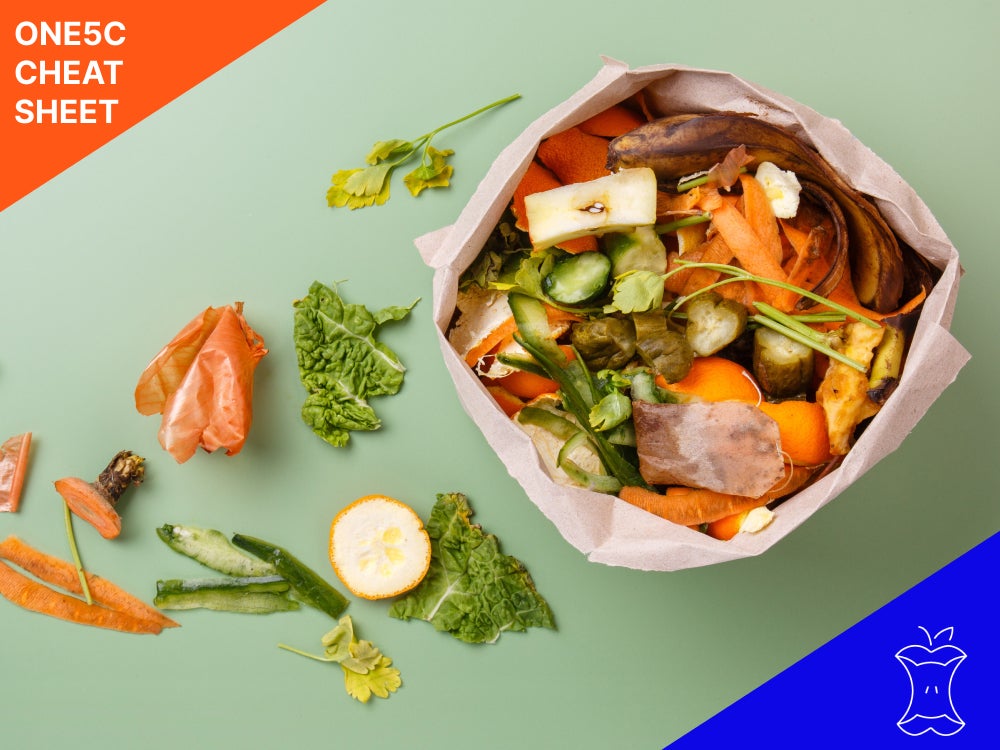The food system in the U.S. (and around the globe) is massive, so it makes sense that there are tons of cracks that food waste can fall down. From farm to table in the U.S., somewhere between 30 to 40 percent of food ends up wasted. This leads to a host of environmental problems—namely the resources we’re chucking every time a perfectly good potato hits the bin, and the methane that creeps out of landfills as food waste breaks down.
Want more Earth-saving tips?
Subscribe to the one5c newsletter here
There are two ways to discuss food that ends up never making it to a mouth. The first is food waste, which is food that is discarded at the consumer or retail level, which makes up a huge chunk of our current food waste problem. The other chunk is called food loss, or the amount of edible food mass that’s lost somewhere before it reaches the consumer—be it in processing or farming. This is especially common in low income countries where food is lost to pests, disease, or mold, according to the World Food Programme, but of course can happen anywhere. Here’s a primer on the sources of food waste and loss, and what we can do about it.
Food waste at home, in restaurants, and in stores
The biggest source of food waste in America is our own kitchens. The average household wastes 31.9% of their grocery cart.1 And typically, people don’t feel great about their waste: A 2015 survey found that 77% of Americans feel guilty when they waste food.2
While they’re not as big of a culprit as household waste, restaurants and grocery stores have their role to play as well. According to ReFED, a nonprofit focused on food waste solutions, restaurants and food service providers wasted about 13 million tons of food a piece in 2022, whereas retailers wasted around 5 million tons that same year.3
The causes of this problem are very similar: buying and producing more than we actually eat. Therefore, the advice for limiting waste that comes out of all three of these sectors has quite a bit of overlap: find a home for leftover food via donations or composting, take expiration dates with a grain of salt, implement “first expired, first out” policies for both fridge and grocery shelves, and audit what is and isn’t getting bought or eaten.
GO DEEPER ABOUT FOOD WASTE SOURCES
Food loss and waste in agriculture
There’s a big difference between food waste at the consumer level and all the steps prior—a final product versus raw, unprocessed plant and animal products that get lost in the agricultural setting. But it’s still a huge problem: The World Wildlife Fund estimates that around 16% of all U.S. food waste comes from grub that never makes it off the farm, and ReFED tallied the total at about 15 million tons of food (about 17%) in the U.S. in 2022.45 The vast vast majority of that waste traces back to crops that were never even harvested. Most of this leftover food decomposes into soil on the farm, but some of it does end up dumped, landfilled, or incinerated.
Luckily, there’s work to be done that can change this. For example, wasted food can become livestock feed. Doing so could divert 2.61 million tons of agricultural food waste in the U.S. every year and create just under 4,000 jobs, according to ReFED research.6
GO DEEPER ABOUT FOOD LOSS SOURCES
- Estimating food waste as household production inefficiency, American Journal of Agricultural Economics, January 2020. ↩︎
- Household food waste: Multivariate regression and principal components analyses of awareness and attitudes among U.S. consumers, PLOS ONE, July 2016. ↩︎
- ReFED Insights Engine. ↩︎
- Ibid ↩︎
- A critical review of on-farm food loss and waste: future research and policy recommendations, Cambridge University Press, May 2023. ↩︎
- ReFED Insights Engine. ↩︎

